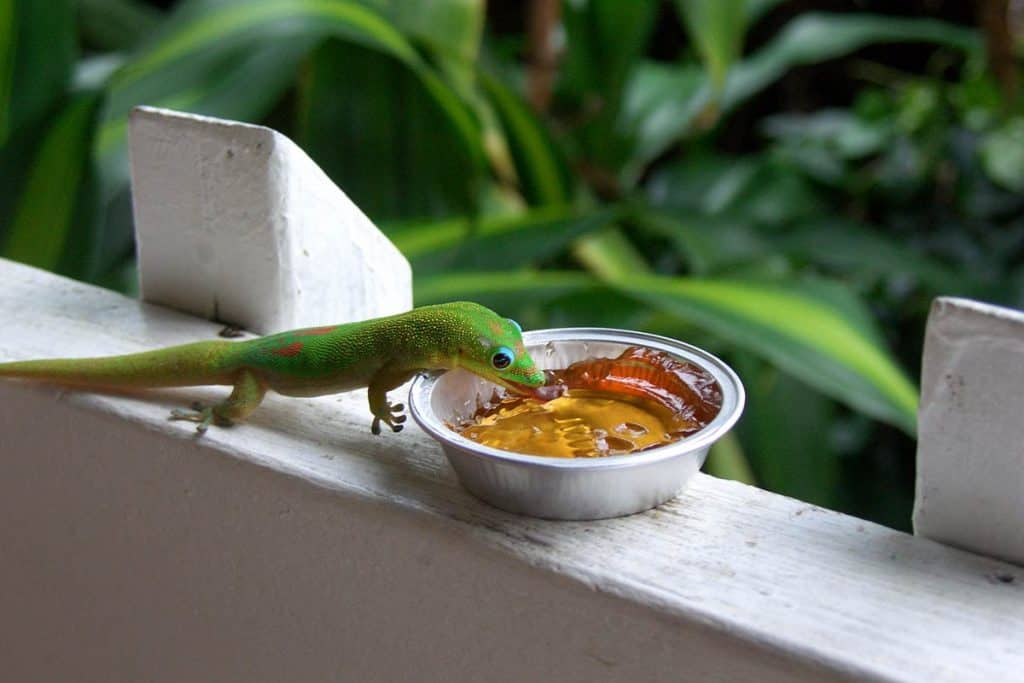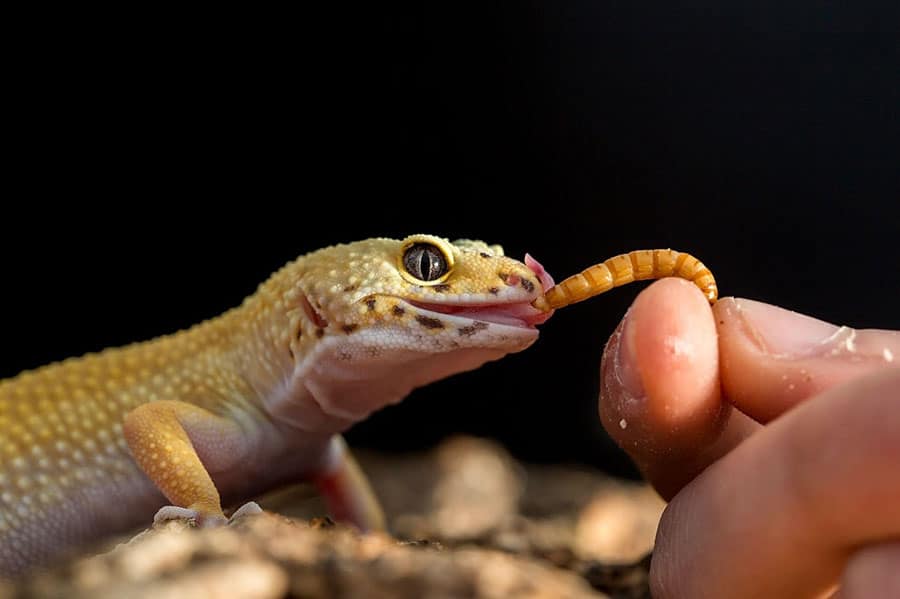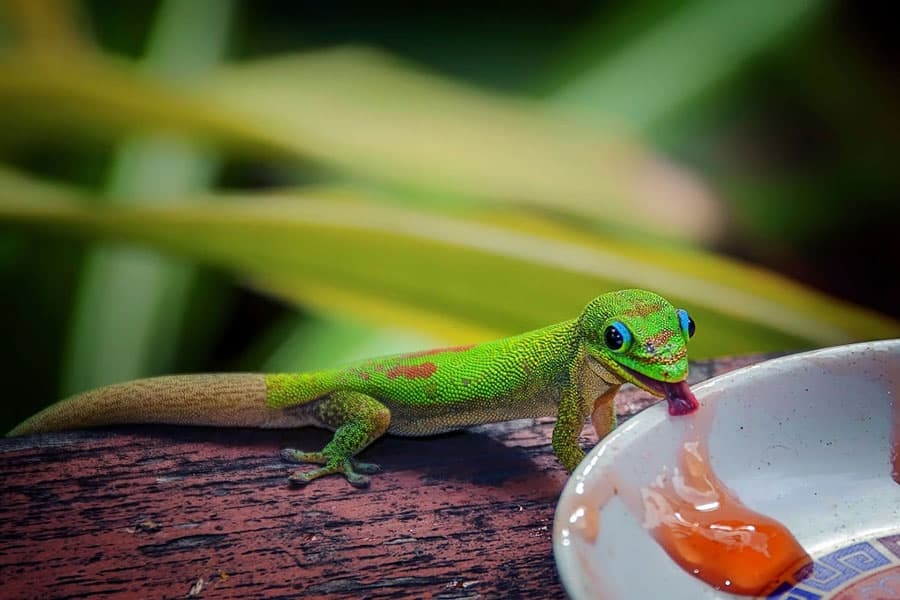
While you might initially believe most geckos can simply eat any bugs they come across, their dietary needs are actually rather complex and specific. There are many different gecko species commonly kept as pets, and they eat anything from insects to fruits and vegetables.
What do geckos eat, specifically? Geckos are typically insectivorous, so most species primarily eat insects like superworms, crickets, and roaches. Some will even eat certain arachnids!
Additionally, many omnivorous and herbivorous species of geckos enjoy fruit, so you’ll often see them described as frugivorous. Day geckos are a great example of a fruit-eating gecko species.
Crested geckos, for example, are fruit-eaters as well, but like most other gecko species, they’re nocturnal. The best time to feed your gecko – if they’re not one of the rare species of diurnal geckos – is in the evening, between 7 PM and 9 PM. Generally, you’ll need to feed most geckos just as it starts to get dark, depending on where you live.
Read on to learn more about what the many species of geckos eat, when to feed them, and other interesting details about their diets in and outside of captivity.
What Can Geckos Eat?
You’ve probably seen wild house geckos going after mosquitoes or foraging in spider webs. This is common for most species of geckos, as they tend to be insectivorous.
However, you will want to make sure your pet gecko doesn’t dip into the household ‘wildlife,’ as they may have parasites or be coated in harmful insecticides. Instead, breed the insects you intend to feed your gecko on your own in a controlled environment or buy them from a trusted source.
Here are some types of insects you can feed most species of insect-eating geckos. These insects are commonly sold at pet shops and by online retailers, though you can also breed them yourself if you wish.
Dubia Roaches
Dubia roaches are illegal in many parts of America and Canada. This is because dubias can quickly go ‘viral’. They’re prolific breeders, and you can go from two to two hundred in weeks if you opt to breed them yourself! This is also why they make such good food for reptiles like bearded dragons and other common pet lizards.
So, if they’re allowed where you live, consider starting a micro-farm for dubia roaches. You can breed them in egg cartons that sit inside plastic containers. It helps to apply a little petroleum jelly at the top of the plastic dish so the roaches don’t crawl up and spread out.
Dubia roaches are great for most geckos because they are highly nutritious and are available in many different sizes. They’re high in protein and low in fat, making them an ideal staple feeder insect.
Worms (Superworms, Mealworms, etc.)
Worms are generally high in fat and protein and are easy to digest, so most insect-loving geckos will greatly enjoy eating them. The main types of worms ideal for geckos are:
- Superworms
- Mealworms
- Hornworms
- Silkworms
- Waxworms (only as a treat, as they are very high in fat)
When it comes to most types of feeder worms, you can easily order live ones, buy dried ones, or breed your own. Beginner parents often opt for frozen, dried, or dormant worms, particularly if they are squeamish about feeding live bugs to their lizards.
Mealworms are the easiest species to breed, but many omnivorous and insectivorous geckos can also eat butterworms, waxworms, hornworms, and silkworms. And yes, your gecko can safely eat any insect that grows from these worms, so if they grow into adult moths or beetles before they get eaten, that’s fine, too.

Locusts and Crickets
These jumping bugs are sure to delight your gecko because they’re so fun to chase. Additionally, you can easily dip the locust or cricket in
Alternatively, you could order them in crates and get a bulk discount. Many will die in transit, so it’s best to get friendly with a nearby pet store and just grab a few dozen live crickets every week or so. Keep in mind, though, that crickets are noisy and smelly, so you won’t enjoy having them in the house for long periods of time!
Crickets and locusts make great staple feeders for most species of geckos because they are rich in protein and fairly low in fat. Plus, they are available in different sizes, so you can find ones that your gecko can easily and safely eat at most pet shops or from online retailers.
Spiders
If your skin just twitched a little upon thinking of these creepy arachnids, that’s normal. These creatures are among the scariest for the average human, but many species of insect-eating geckos love them. While they aren’t the best staple insects, some spiders can make a great treat.
Many geckos eat spiders all the time in the wild, and they are quite good at hunting them. So, if you can buy captive-bred, non-venomous spiders that are small enough for your gecko to eat safely, go for it. Just be sure to never feed your gecko wild-caught spiders, as they may have parasites or be coated in harmful insecticides.
Another thing to keep in mind is that spiders are a tricky menu item because it’s hard to breed them at home. Even if you buy live ones at a pet shop or online retailer, offering them to your gecko without getting bitten (or dying of fright) is a complicated task.
Generally, it’s best to opt for the aforementioned insects rather than spiders, but they are still worth mentioning.
Supplements
Your beloved scale babies need two main supplements to thrive in captivity:
Geckos can generate a little vitamin D on their own with added UVB lighting, but it helps to purchase a
calcium supplement with it added in.
Unlike diurnal bearded dragons, most species of geckos spend most of the day hiding. They don’t need as much sunlight, so if you dust their food with
You can also offer supplements to live food (aka gut-loading) the day before your gecko eats them. Simply coat any food items you give to your insects with the supplement.
What Can’t Geckos Eat?
Because most geckos commonly kept as pets are insectivorous, they shouldn’t be eating any fruits or vegetables. So, unless you have a day gecko, crested gecko, or one of the other few species that are herbivorous, they shouldn’t eat plant matter.
Many scale parents default to worms such as mealworms as their chosen gecko food. These are a good choice as they are quite nutritious and inexpensive.
However, while worms such as waxworms and superworms are a good choice as a treat, they’re fatty and could give your gecko obesity. Offer high-fat worms sparingly, or around once or twice a week.
Finally, you might hear that geckos can eat small animals like pinkie mice or even baby birds. In the wild, yes, it is true that many species of geckos commonly eat these larger animals–when they are desperate. It’s best to avoid them in captivity, as they are too large for most smaller species of geckos to consume safely without risking choking or impaction.
When Should You Feed Your Gecko?
Crepuscular leopard geckos are the most popular species of pet gecko, closely followed crested geckos. This means they prefer to eat in the evening, as that is when they are most active.
Kids may prefer a diurnal species such as the day gecko since leopard and crested geckos are asleep most of the day. However, if you do opt for a herbivorous or omnivorous lizard like a crested gecko, keep in mind that they need fruits and vegetables added to their diet.

That said, a ‘night gecko’ can still be suitable for a school-going child, because the gecko is most active at dawn and dusk, which can work with a child’s school schedule and bedtime routine. The kids can feed the gecko before bed and play with the gecko before school.
Baby and juvenile geckos need to eat a couple of times every day, while adults can skip a day or two between feedings.
On average, a young gecko should eat around 5 to 10 bugs a day, depending on their size and type, as baby and juvenile geckos have fast metabolisms and rapidly growing bodies. Adult geckos only need 5 to 10 bugs every 2 or 3 days once they’ve reached full size and their metabolism has leveled off.
Remember, live insects are best, as they’ll hone your gecko’s hunting instincts and keep them active. Dormant worms work too, because they can be freeze-dried. When you take them out of the freezer or fridge and thaw them out, they will gradually wriggle back to life, drawing your gecko’s attention and triggering the gecko to chase, grab, and feed.
FAQs About Gecko Diets
You now have a comprehensive idea of what foods your gecko can eat, depending on their species, size, and age. However, you probably still have some additional questions. Look through the commonly asked ones below, and add yours in the comments!
Is my gecko underweight?
The answer to this question will depend largely on your gecko’s species, age, and sex.
Scientists have identified close to 1,500 gecko species. They range in size from 0.6 inches to 17 inches, though the average length of a pet gecko is 10 inches. They also vary significantly in weight, from a few grams to a few hundred. Caledonian giant geckos, for example, hover around 200 to 300 grams. You will need to look up the species of your gecko and find a detailed weight chart for that specific type of lizard.
The best way to assess your gecko’s weight is to keep journals for your gecko’s food, water, growth, sleep, and poop. It can be a physical notebook or even a smartphone notes app.
Carefully note what you feed them, how much, at what time, when they eat, when they sleep, and when you last misted their tank. At first, note their weight every day, then as they reach full size, weigh them every week. These diaries will show you your gecko’s weight range and if they experience any sudden weight gain or loss so you’ll know when to worry and call the vet.
How do I know what species my gecko is?
There are over a thousand gecko species, but only a handful of them are kept as pets. So you can look up gecko images online to get a rough idea of your gecko breed. You can also ask the pet store or breeder you bought your gecko from.
Additionally, if you suffer from entomophobia, also simply known as a fear of insects, you should probably look for a fruit-eating gecko species to save yourself from having to regularly handle creepy crawlies.
What happens if I feed my gecko during the day?
Most pet geckos are considered nocturnal, though you may also see them being described as crepuscular. This means they’re most active during twilight hours (late evening and early morning). It’s an evolutionary adaptation because in the wild, that’s when gecko prey comes out to play, so it’s the optimal time to hunt.
If you feed your nocturnal or crepuscular gecko during daylight hours, you might disrupt their circadian rhythm. Imagine how cranky you’d be if someone kept waking you at 2 AM for a heavy meal!
What if I forget to feed my gecko?
Like many lizards, most geckos store excess fat in their tails. This means they have adapted to survive for a while if you happen to forget their nightly feed.
A baby gecko can go three or four days without eating, especially if they have access to water. An adult gecko can live through a hunger strike for up to two weeks, though this should be avoided, as surviving off their fat stores alone is very stressful for them.
Do geckos need UVB lights for digestion?
Of the top pet gecko species, only a few are diurnal. These diurnal breeds benefit from UVB lights, as they mimic the natural sunlight in their natural habitats.
However, most other species of geckos are nocturnal or crepuscular, meaning they feed and hunt just after sunset and just before sunrise. This means their bodies are designed to digest in the dark. You can leave the lights off after dinner or get a gecko night light if you want to watch them while they’re active, but they generally don’t need UVB.
That said, there’s no harm in having a dual light setup, since the UVB will help with
Finishing Up…
The best way to feed your gecko is to let them join you for dinner. No, that doesn’t mean feeding them off your plate. It means planning your evening routine around gecko feeding, ideally between 7 PM and 9 PM, since this is when the vast majority of gecko species are most active.
So, in conclusion, what do geckos eat? Offer a healthy mix of insects such as gut-loaded crickets, dubia roaches, worms, and locusts. And never let them hunt ‘wild’ bugs or eat large prey like mice or birds!

